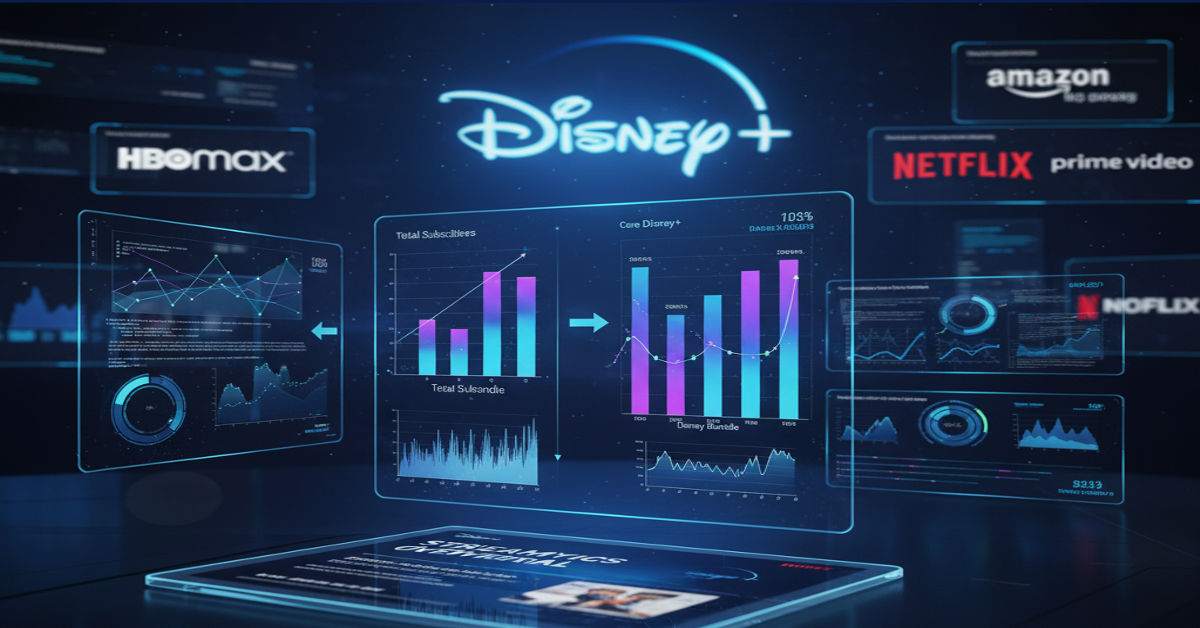The streaming landscape is undergoing a fundamental transformation and Disney’s recent decision to stop reporting Disney+ subscriber numbers regularly has sparked wide discussion among analysts, investors and consumers. This article explores what the reporting Disney+ Subscriber Numbers Reporting Change why the company made this move and how it may redefine the way success is measured across the streaming industry.
Background on Disney+ and the streaming market
Disney+ was launched in November 2019, offering a vast library that spans Disney classics, Marvel, Star Wars, Pixar, and National Geographic. It quickly became one of the fastest-growing streaming platforms globally surpassing 100 million subscribers within 18 months. Over time, however, the market matured. Competition intensified, and profitability replaced growth as the core focus for streaming giants.
The streaming ecosystem now values engagement, advertising revenue and average revenue per user more than raw subscriber counts. Disney’s move to change its reporting structure reflects this evolution, aligning with the overall industry direction.
What has changed: The subscriber numbers reporting decision
In August 2025, Disney announced that it would no longer provide quarterly subscriber counts or ARPU figures for Disney+, Hulu, and ESPN+. For ESPN+, this change takes effect in fiscal Q4 2025, while Disney+ and Hulu will transition in fiscal 2026. The company said that paid subscriber counts and ARPU had become less meaningful for evaluating business performance.
Before the reporting change, Disney+ disclosed 127.8 million subscribers globally as of June 28 2025, with 57.8 million in the US and Canada and 69.9 million internationally.
| Region | Paid Subscribers (in millions) | Average Monthly Revenue per Paid User (US$) |
| Domestic (US & Canada) | 57.8 | 8.09 |
| International | 69.9 | 7.67 |
| Global Total | 127.8 | 7.86 |
This data provides a final detailed look before the new disclosure policy takes effect, marking the end of an era in which subscriber growth was the main headline metric.
Why the change is happening
Several structural and strategic reasons drive this shift:
- Market maturity: Disney+ and other streamers have reached high penetration levels, and incremental growth has slowed.
- Profitability focus: Disney’s streaming division is now judged more by operating income and ARPU than by total user counts.
- Integration of platforms: The merger of Hulu into Disney+ means reporting individual subscriber numbers becomes less relevant.
- Industry precedent: Netflix’s decision in 2024 to stop publishing quarterly subscriber updates influenced Disney’s move.
| Service | Reporting Change Date | Notes |
| ESPN+ | Q4 Fiscal 2025 | Will stop disclosing paid-subscriber counts and ARPU |
| Disney+ & Hulu | Q1 Fiscal 2026 | Regular subscriber number disclosure ends |
| Milestone Updates | Ongoing | Disney will still announce major threshold achievements |
The table clarifies the timing and implementation plan showing how Disney is aligning all its streaming assets under a unified disclosure policy.
What this means for Disney+ growth and monetisation
The change signals a new phase where Disney+ focuses on quality of revenue rather than raw quantity of subscribers.
- Shift to profitability: Disney reported ARPU growth in both domestic and international markets during Q3 2025.
- Emphasis on bundled offerings: The Disney+, Hulu, and ESPN bundle drives higher retention and cross-engagement.
- Increased role of advertising: Ad-supported tiers are becoming a significant contributor to revenue growth.
- Operational efficiency: By consolidating technology and content across services, Disney can improve margins.
This evolution allows Disney to highlight engagement, retention, and ad revenue as the new success metrics.
Who benefits and who may lose from the shift
Winners:
- Disney’s management, as performance will be judged by profitability rather than subscriber growth alone.
- Investors focused on sustainable earnings.
- Creative teams that can prioritize high-value content designed for retention.
Potential losers:
- Analysts seeking granular subscriber data will have less transparency.
- Smaller competitors who benchmark themselves against Disney’s public numbers.
- Viewers who might face price changes or tier adjustments as monetisation increases.
Disney+ versus competitors
Even with the upcoming disclosure change, comparing Disney+ to peers provides insight into how the industry is evolving.
| Platform | Approx. Paid Subscribers | ARPU / Monetisation Focus | Reporting Transparency |
| Disney+ | 127.8 million | Domestic US$8.09 / Intl US$7.67 | Ending quarterly subscriber reporting in FY 2026 |
| Netflix | Not regularly disclosed | Focuses on revenue and margin | Stopped detailed sub reporting in 2024 |
| Hulu | 55.5 million | ARPU ~ US$12.40 (SVOD) | Will merge into Disney+ reporting |
| ESPN+ | 24.1 million | Sports-focused niche | Ending regular reporting in FY 2025 |
This comparison demonstrates that Disney is following a broader industry pattern where subscriber numbers are being replaced by monetisation metrics and profitability indicators.
Impact on investors and market perception
Investors traditionally viewed subscriber growth as the primary gauge of streaming success. The reporting change alters that perception significantly.
- Analyst recalibration: Market analysts will now focus more on revenue per user, churn rates, engagement, and profit margins.
- Short-term uncertainty: Some investors may be cautious due to reduced visibility into user growth.
- Long-term advantage: By emphasizing profitability, Disney aligns investor expectations with sustainable business performance.
The strategic message is clear: Disney is moving from being a high-growth disruptor to a stable, profitable media ecosystem.
Implications for content and user experience
For viewers, the reporting change may seem distant, but it carries real effects on programming and pricing.
- Disney could prioritize premium, franchise-based content that maximizes engagement.
- Bundles combining Disney+, Hulu and ESPN content are likely to become the standard.
- Ad-supported tiers may grow, giving users more choice while boosting revenue.
- The company might streamline content spending, focusing on titles with proven demand and long-term value.
| Old Focus | New Focus | Business Rationale |
| Subscriber Count Growth | Profitability and Engagement | Mature market dynamics |
| Individual Platform Reporting | Integrated Streaming Ecosystem | Simplifies analysis |
| Content Volume | High-Impact Franchises | Enhances retention and ARPU |
| Global Scale | Localisation and Ad Monetisation | Aligns with profitability goals |
This table illustrates Disney’s pivot from quantity-driven goals to sustainable value creation through engagement and monetisation.
Risks and concerns around less transparency
While the move aligns with profitability goals, it comes with potential downsides:
- Reduced transparency could limit investor confidence.
- Analysts might find it difficult to assess subscriber trends accurately.
- Integrating data from multiple services could mask performance issues.
- If user engagement falls, fewer public metrics may delay detection of problems.
To mitigate these risks, Disney must ensure that alternative metrics—like engagement hours, ARPU growth, and content profitability—are disclosed clearly and consistently.
Future outlook for Disney’s streaming strategy
Disney’s broader streaming roadmap indicates a shift toward integration and monetisation efficiency:
- The merger of Hulu into Disney+ will create a unified experience by 2026.
- ESPN will expand digital and live-sports content under the Disney umbrella.
- Disney plans to rely more heavily on advertising and cross-promotion between its services.
- Global expansion will continue but with stronger localisation and targeted pricing strategies.
- Future reporting will focus on milestones such as revenue targets and engagement growth rather than raw subscriber counts.
This vision underscores Disney’s transformation from a subscription-driven company into a full-spectrum digital media powerhouse.
Conclusion & Call-to-Action
The Disney+ Subscriber Numbers Reporting Change marks a pivotal turning point in streaming history. It reflects the industry’s shift from the growth-at-all-costs mindset toward a balanced focus on profitability, retention and engagement.
For investors, this means looking beyond subscriber numbers to understand the company’s financial health through new metrics like ARPU and operating margins. For viewers, it could lead to improved bundles, diversified pricing and better-curated content.
To stay ahead in understanding streaming trends, keep following our industry insights and subscribe to our newsletter. Share this Disney+ Subscriber Numbers Reporting Change article with colleagues or friends interested in the evolving economics of the digital entertainment world.







